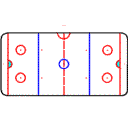
Situations about the
Rink (Section 100)

Situation: Goal Posts and Nets
Is the two inch thickness of the red goal line considered
to be part of the goal line?
Response: Yes.
Rule reference 103 (e).
The thickness of the goal line is considered to be a part of
the line. In order for a goal to be allowed or Icing to be called, the ENTIRE
puck must COMPLETELY cross the edge closer to the end boards.
Go to Rule Links Back to Situations Main
Situation: Division of Ice Surface
In which zone are the Blue Lines considered to be a part?
Response:
See Rule References 105 (b) and 626.
The zone in which the puck is located. Rule Reference 105(b).
For application, see Rule 626 - Off-Side.
The Blue Line may be a part of the Neutral Zone and then
switch to be a part of the Attacking/Defending Zone. The determining edge of the
Blue Line is always the edge further from the zone in which the puck is located.
Go to Rule Links Back to Situations Main
Situation: Off-sides Response: No.
Rule References 105 (b) and 626 (a).
The puck is in possession of the attacking team in the Attacking
Zone. The puck is passed back to the Blue Line by an attacking player. The pass
is received by a teammate on the far edge of the Blue Line (half on the line,
and half in the Neutral Zone), and then is shot on goal. Has an off-sides
infraction occurred?
The line is always part of the zone in which the puck is located. In this
instance, the line is part of the Attacking Zone. So the puck is still in the
Attacking Zone, until it COMPLETELY crosses the line, and is completely in the
white part of the Neutral Zone. Now that the puck is in the Neutral Zone, BOTH
Blue Lines are part of the Neutral Zone.
Go to Rule Links
Back to Situations Main
Situation:
A player shoots the puck into her opponent's Defending Zone. The puck leaves
the stick directly on the center red line (for Maroon, Blue Divisions; defending
blue line for Green & Red). Assume the puck has been advanced from the shooting
player's Defending Zone. Is this a potential icing?
Response: Yes. Rule References 620 (a) and 105 (b &
c).
The determining edge of the center red line (or defending blue line for Green &
Red Divisions) is the edge of the line further from the half of the ice in which
the puck is located. [In this case, the determining edge is the edge furthest
from the shooter's Defending Zone.] Since the puck is shot from a point behind
this line, potential icing applies, and the back official should signal
potential icing.
If the puck was COMPLETELY (100%) in front of the determining edge, potential
icing does not apply. When it is unsure as to where the puck exactly left the
stick, the back official should always give the player shooting the puck the
benefit and wash out the icing infraction.
Go to Rule Links Back to Situations Main
Situation: Signal & Timing Devices
A face-off occurs with ten seconds remaining in the period. As
play begins, one of the On-Ice Officials notices that the clock has not started.
Should the Official stop play immediately to remedy the situation?
Response: No.
Rule reference 111 (b).
As soon as the Official notices that the clock has not
started, she must begin counting down the remaining seconds in her head. If she
counts down to 0:00 and the period should have ended, but didn't (the horn
didn't sound), she must stop the play to end the period.
If the Official properly counts down to 0:00 in the above situation, but does not stop the play for whatever reason, any goal that has been scored after she counts down to 0:00 shall be disallowed.
This page was last modified: